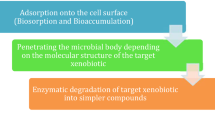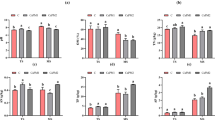Abstract
The degradation of 2-chloroethanol by Pseudomonas putida US2 was investigated in batch, repeated batch and continuous cultures especially in a packed-bed fermenter with sand. The degradation of 2-chloroethanol was connected with a release of protons, which led to a decrease of the pH in the medium. Higher initial concentration than 25 mM 2-chloroethanol were not degraded completely because they entailed a decrease of the pH to 5.0, which inhibited further growth and degradation. P. putida US2 showed a typical repression of catabolites and diauxic growth with succinate as cosubstrate. The addition of succinate as a second substrate caused a decrease in degradation of 2-chloroethanol. Activated sludge added to adsorbed cultures in a continuous fermentation did not lead to a decrease in metabolic activity. After 2 weeks of continuous cultivation the specialized strain could be retained.
Similar content being viewed by others
References
Balfanz J, Rehm H-J (1991) Biodegradation of 4-chlorophenol by adsorptive immobilized Acaligenes sp. A 7–2 in soil. Appl Microbiol Biotechnol 35:662–668
Bergmann JG, Sanik J (1957) Determination of trace amounts of chlorine in naphtha. Anal Chem 29:241–243
Bettmann H, Rehm H-J (1985) Continuous degradation of phenol(s) by Pseudomonas putida P8 entrapped in polyacryamid-hydrazide. Appl Microbiol Biotechnol 20:389–393
Clark PH, Richmond HH (1975) Genetics and biochemistry of Pseudomonas. J Wiley, London New York
Greer CW, Beaumier D, Sammson R (1989) Application of on-line sensors during growth of the dichloroethane degrading bacterium X anthobacter autotrophicus. J Biotechnol 12:261–274
Hofmann K (1987) Technischer Anforderungen an den Umgang mit CKW aus technischer Sicht. Vortrag zum Lehrgang 9240/11.028 an der technischen Akademie Esslingen am 09./10.03.1987
Janssen DB, Scheper A, Witholt B (1984) Biodegradation of 2-chloroethanol and 1,2-dichloroethane by pure bacterial cultures. In: Houwink EH, Vanden Meer RR (eds) Innovations in biotechnology. Elsevier, Amsterdam, pp 169–179
Janssen DB, Scheper A, Djihuizen L, Witholt B (1985) Degradation of halogenated aliphatic compounds by X anthobacter autotrophicus GJ 10. Appl Environ Microbiol 49:673–677
Janssen DB, Keuning S; Witholt B (1987) Involvement of a quinoprotein alcohol dehydrogenase and a NAD dependent aldehyde dehydrogenase in 2-chloroethanol-metabolism in X anthobacter autotrophicus GJ 10. J Gen Microbiol 133:85–92
Knippschild M, Rehm HJ (1995) Degradation of 2-chloroethanol by free and immobilized Pseudomonas putida US2. Appl Microbiol Biotechnol (in press)
Matin A, Konings WN (1973) Transport of lactate and succinate by membrane vesicles of Escherichia coli, Bacillus subtilis and a Pseudomonas species. Eur J Biochem 34:58–67
Omori T, Kimura T, Kodama T (1987) Bacterial cometabolic degradation of chlorinated paraffins. Appl Microbiol Biotechnol 25:533–557
Scholz-Muramatsu H, Flemming HC (1992) Unter welcehn Bedingungen können leichtflüchtige CKW in der Natur abgebaut werden. In: Biologischer Abbau von Chlorkohlenwasserstoffen: Kolloquium an der TU Berlin, 21–22 November 1991, Technische Universität, Berlin. pp 163–185
Steinhäuser KG (1987) Bewertung der CKW aus wasserwirtschaftlicher Sicht Vortrag zum Lehrgang 9240/11.028 an der technischen Akademie Esslingen, 09./10.3.1987
Strotmann U, Petenga M, Janssen DB (1990) Degradation of 2-chloroethanol by wild type and mutants of Pseudomonas putida US 2. Arch Microbiol 154:294–300
Werner P (1991) Praktische Erfahrung mit der mikrobiologischen Bodensanierung — in situ — Verfahren. In: Behrens D, Wiesner J (eds) Mikrobiologische Reinigung von Böden: Beiträge des 9. DECHEMA-Fachgesprächs Umweltschutz am 27./28.02.1991 in Frankfurt am Main. DECHEMA, Frankfurt am Main; VCH, Weinheim, pp 181–203
Westmeyer F, Rehm H-J (1987) Degradation of 4-chlorophenol in municipal wastewater by adsorptive immobilized Alcaligenes sp. A 7–2. Appl Microbiol Biotechnol 26:78–83
Author information
Authors and Affiliations
Rights and permissions
About this article
Cite this article
Overmeyer, C., Rehm, HJ. Biodegradation of 2-chloroethanol by freely suspended and adsorbed immobilized Pseudomonas putida US2 in soil. Appl Microbiol Biotechnol 43, 143–149 (1995). https://doi.org/10.1007/BF00170636
Received:
Revised:
Accepted:
Issue Date:
DOI: https://doi.org/10.1007/BF00170636




